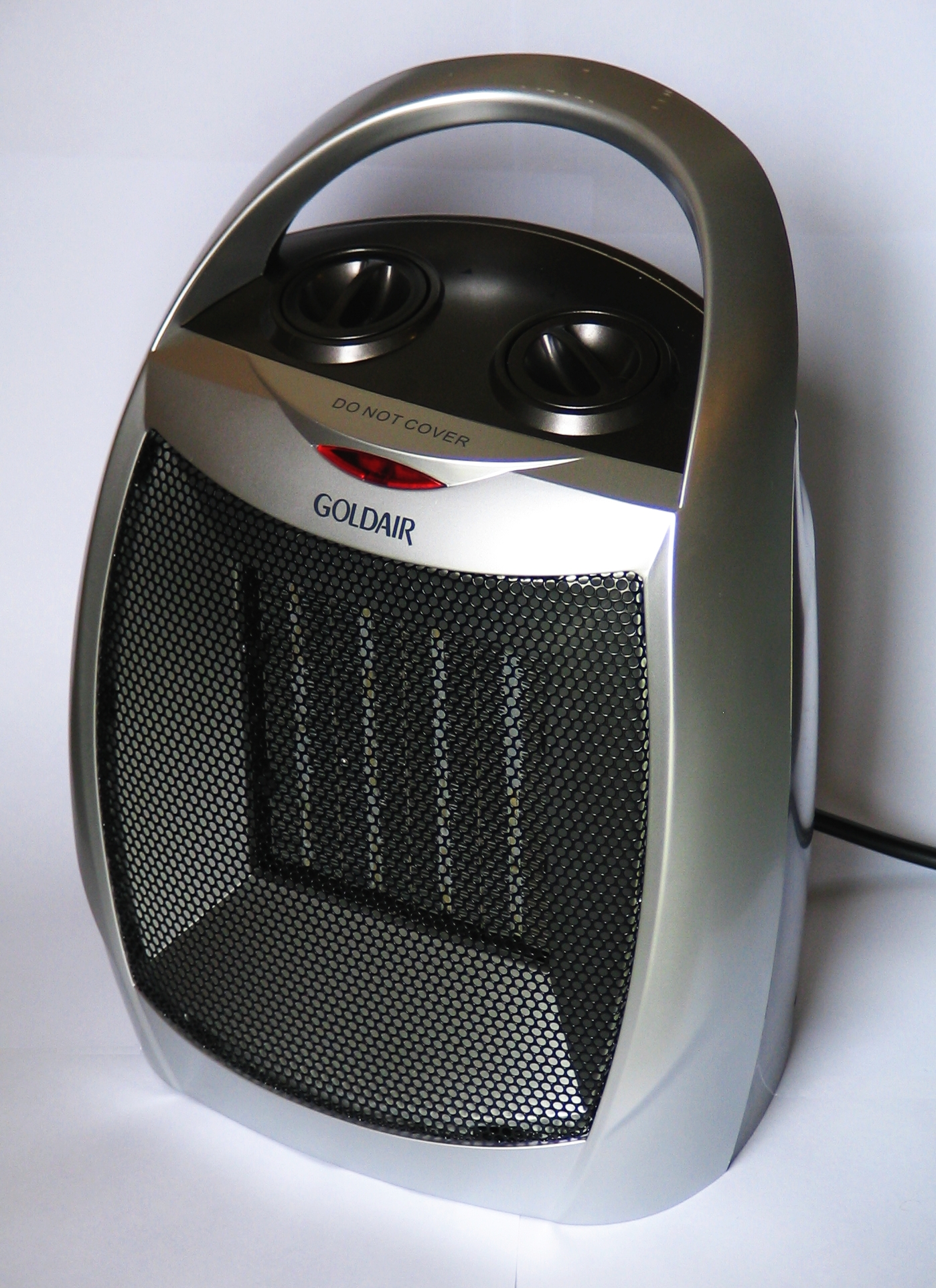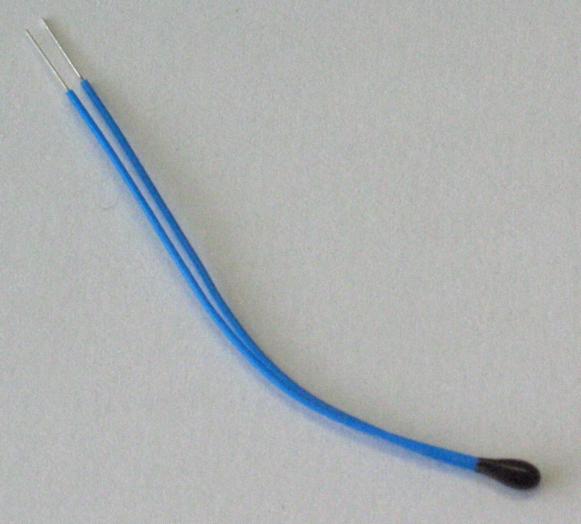|
Ceramic Heater
A ceramic heater as a consumer product is a space heater that generates heat using a heating element of ceramic with a Thermistor#PTC, positive temperature coefficient (PTC). Ceramic heaters are usually portable and typically used for heating a room or small office, and are of similar utility to metal-element fan heaters. Heating principle PTC ceramic material is Semiconductive, semi-conductive and when voltage is applied to it, the power decreases quickly as it reaches a certain temperature according to the particular composition of the ceramic. The ceramic elements are in contact with aluminium fins, thereby heating the fins up. A fan blowing across the fins heats the air. Differences from other electric heaters Electric heating elements made of resistance wire also have a positive temperature coefficient of resistivity, but do not increase their resistance enough to be self-regulating; they are typically used with the wires red heat, red-hot. The ceramic, on the other han ... [...More Info...] [...Related Items...] OR: [Wikipedia] [Google] [Baidu] |
Space Heater
A space heater is a device used to heat a single, small to medium sized area. Operation Electric space heaters fall into four main categories: fan heaters, ceramic, infrared, and oil-filled. * Fan heaters are the cheapest, but are often the least efficient and versatile. Nonetheless, they can be useful for heating small spaces, such as a small room or office cubicle. * Ceramic heaters push air across a piece of heated ceramic material. They can adequately heat a typical bedroom. * Infrared heaters provide more heat than ceramic models, and are also smaller and quieter. They do not oscillate like ceramic heaters, but consist of a heating chamber deep within the unit that prevent accidental fires, and allows for greater accumulation of heat before it is emitted by the unit. By the mid-2010s, many were outfitted with touch-screen controls and energy-saving settings, and were styled in such a way to complement the user's furniture. They grew in popularity in the 2010s. * Oi ... [...More Info...] [...Related Items...] OR: [Wikipedia] [Google] [Baidu] |
Heating Element
A heating element converts electrical energy into heat through the process of Joule heating. Electric current through the element encounters resistance, resulting in heating of the element. Unlike the Peltier effect, this process is independent of the direction of current. Heating elements types Metal Resistance wire: Metallic resistance heating elements may be wire or ribbon, straight or coiled. They are used in common heating devices like toasters and hair dryers, furnaces for industrial heating, floor heating, roof heating, pathway heating to melt snow, dryers, etc. The most common classes of materials used include: * Nichrome: Most resistance wire heating elements usually use nichrome 80/20 (80% Nickel, 20% Chromium) wire, ribbon, or strip. Nichrome 80/20 is an ideal material, because it has relatively high resistance and forms an adherent layer of chromium oxide when it is heated for the first time. Material beneath this layer will not oxidize, preventing the wire ... [...More Info...] [...Related Items...] OR: [Wikipedia] [Google] [Baidu] |
Thermistor
A thermistor is a type of resistor whose resistance is strongly dependent on temperature, more so than in standard resistors. The word thermistor is a portmanteau of ''thermal'' and ''resistor''. Thermistors are divided based on their conduction model. Negative Temperature Coefficient (NTC) thermistors have ''less'' resistance at ''higher'' temperatures, while Positive Temperature Coefficient (PTC) thermistors have ''more'' resistance at ''higher'' temperatures. Hence, a PTC thermistor's resistance is directly proportional to temperature. NTC thermistor are widely used as inrush current limiters, temperature sensors, while PTC thermistors are used as self-resetting overcurrent protectors, and self-regulating heating elements. An operational temperature range of a thermistor is dependent on the probe type and is typically between −100 °C and 300 °C (−148 °F and 572 °F). Types Depending on materials used, thermistors are classified into two types: *With ''NTC'' the ... [...More Info...] [...Related Items...] OR: [Wikipedia] [Google] [Baidu] |
Fan Heater
A fan heater, also called a blow heater, is a heater that works by using a fan to pass air over a heat source (e.g. a heating element). This heats up the air, which then leaves the heater, warming up the surrounding room. They can heat an enclosed space such as a room faster than a heater without fan, but like any fan, creates audible noise. Cost and efficiency Electric fan heaters can be less expensive to buy than other heaters due to simple construction. The fan carries heat away from the device, which can be made smaller without overheating. The relatively small amount of electricity used to operate the fan is converted to additional heat, so that efficiency is not a problem. Electric fan heaters are more expensive to run than fuel powered heaters due to the cost of electricity. This makes them best suited to occasional use rather than as regularly used heat sources. Residential electric fan heaters are limited in capacity by the voltage of the electrical system, in 110/1 ... [...More Info...] [...Related Items...] OR: [Wikipedia] [Google] [Baidu] |
Semiconductive
A semiconductor is a material which has an electrical conductivity value falling between that of a conductor, such as copper, and an insulator, such as glass. Its resistivity falls as its temperature rises; metals behave in the opposite way. Its conducting properties may be altered in useful ways by introducing impurities (" doping") into the crystal structure. When two differently doped regions exist in the same crystal, a semiconductor junction is created. The behavior of charge carriers, which include electrons, ions, and electron holes, at these junctions is the basis of diodes, transistors, and most modern electronics. Some examples of semiconductors are silicon, germanium, gallium arsenide, and elements near the so-called " metalloid staircase" on the periodic table. After silicon, gallium arsenide is the second-most common semiconductor and is used in laser diodes, solar cells, microwave-frequency integrated circuits, and others. Silicon is a critical element for ... [...More Info...] [...Related Items...] OR: [Wikipedia] [Google] [Baidu] |
Voltage
Voltage, also known as electric pressure, electric tension, or (electric) potential difference, is the difference in electric potential between two points. In a static electric field, it corresponds to the work needed per unit of charge to move a test charge between the two points. In the International System of Units, the derived unit for voltage is named ''volt''. The voltage between points can be caused by the build-up of electric charge (e.g., a capacitor), and from an electromotive force (e.g., electromagnetic induction in generator, inductors, and transformers). On a macroscopic scale, a potential difference can be caused by electrochemical processes (e.g., cells and batteries), the pressure-induced piezoelectric effect, and the thermoelectric effect. A voltmeter can be used to measure the voltage between two points in a system. Often a common reference potential such as the ground of the system is used as one of the points. A voltage can represent either a source ... [...More Info...] [...Related Items...] OR: [Wikipedia] [Google] [Baidu] |
Resistance Wire
Resistance wire is wire intended for making electrical resistors (which are used to control the amount of current in a circuit). It is better if the alloy used has a high resistivity, since a shorter wire can then be used. In many situations, the stability of the resistor is of primary importance, and thus the alloy's temperature coefficient of resistivity and corrosion resistance play a large part in material selection. When resistance wire is used for heating elements (in electric heaters, toasters, and the like), high resistivity and oxidation resistance is important. Sometimes resistance wire is insulated by ceramic powder and sheathed in a tube of another alloy. Such heating elements are used in electric ovens and water heaters, and in specialized forms for cooktops. __TOC__ Types Nichrome, a non-magnetic 80/20 alloy of nickel and chromium, is the most common resistance wire for heating purposes because it has a high resistivity and resistance to oxidation at high tempe ... [...More Info...] [...Related Items...] OR: [Wikipedia] [Google] [Baidu] |
Resistivity
Electrical resistivity (also called specific electrical resistance or volume resistivity) is a fundamental property of a material that measures how strongly it resists electric current. A low resistivity indicates a material that readily allows electric current. Resistivity is commonly represented by the Greek letter (rho). The SI unit of electrical resistivity is the ohm-meter (Ω⋅m). For example, if a solid cube of material has sheet contacts on two opposite faces, and the resistance between these contacts is , then the resistivity of the material is . Electrical conductivity or specific conductance is the reciprocal of electrical resistivity. It represents a material's ability to conduct electric current. It is commonly signified by the Greek letter ( sigma), but (kappa) (especially in electrical engineering) and (gamma) are sometimes used. The SI unit of electrical conductivity is siemens per metre (S/m). Resistivity and conductivity are intensi ... [...More Info...] [...Related Items...] OR: [Wikipedia] [Google] [Baidu] |
Red Heat
The practice of using colours to determine the temperature of a piece of (usually) ferrous metal comes from blacksmithing. Long before thermometers were widely available it was necessary to know what state the metal was in for heat treating it and the only way to do this was to heat it up to a colour which was known to be best for the work. Chapman According to Chapman's ''Workshop Technology'', the colours which can be observed in steel are: Stirling In 1905, Stirling Consolidated Boiler Company published a slightly different set of values: See also *Black-body radiation *Color temperature Color temperature is the color of light emitted by an idealized opaque, non-reflective body at a particular temperature measured in kelvins. The color temperature scale is used to categorize the color of light emitted by other light sources ... * Incandescence References {{Reflist Metallurgy Temperature ... [...More Info...] [...Related Items...] OR: [Wikipedia] [Google] [Baidu] |
Curie Temperature
In physics and materials science, the Curie temperature (''T''C), or Curie point, is the temperature above which certain materials lose their permanent magnetic properties, which can (in most cases) be replaced by induced magnetism. The Curie temperature is named after Pierre Curie, who showed that magnetism was lost at a critical temperature. The force of magnetism is determined by the magnetic moment, a dipole moment within an atom which originates from the angular momentum and spin of electrons. Materials have different structures of intrinsic magnetic moments that depend on temperature; the Curie temperature is the critical point at which a material's intrinsic magnetic moments change direction. Permanent magnetism is caused by the alignment of magnetic moments and induced magnetism is created when disordered magnetic moments are forced to align in an applied magnetic field. For example, the ordered magnetic moments (ferromagnetic, Figure 1) change and become disorder ... [...More Info...] [...Related Items...] OR: [Wikipedia] [Google] [Baidu] |
Degrees Celsius
The degree Celsius is the unit of temperature on the Celsius scale (originally known as the centigrade scale outside Sweden), one of two temperature scales used in the International System of Units (SI), the other being the Kelvin scale. The degree Celsius (symbol: °C) can refer to a specific temperature on the Celsius scale or a unit to indicate a difference or range between two temperatures. It is named after the Swedish astronomer Anders Celsius (1701–1744), who developed a similar temperature scale in 1742. Before being renamed in 1948 to honour Anders Celsius, the unit was called ''centigrade'', from the Latin ''centum'', which means 100, and ''gradus'', which means steps. Most major countries use this scale; the other major scale, Fahrenheit, is still used in the United States, some island territories, and Liberia. The Kelvin scale is of use in the sciences, with representing absolute zero. Since 1743 the Celsius scale has been based on 0 °C for the freezing ... [...More Info...] [...Related Items...] OR: [Wikipedia] [Google] [Baidu] |








